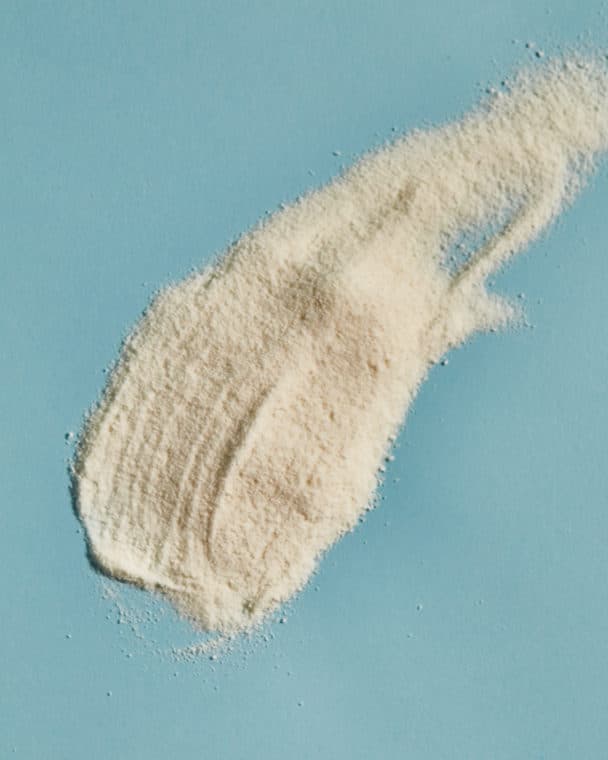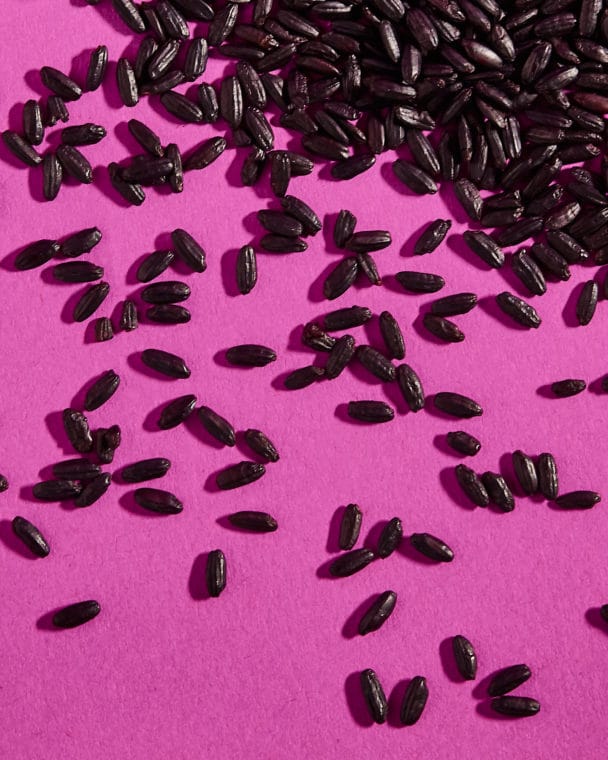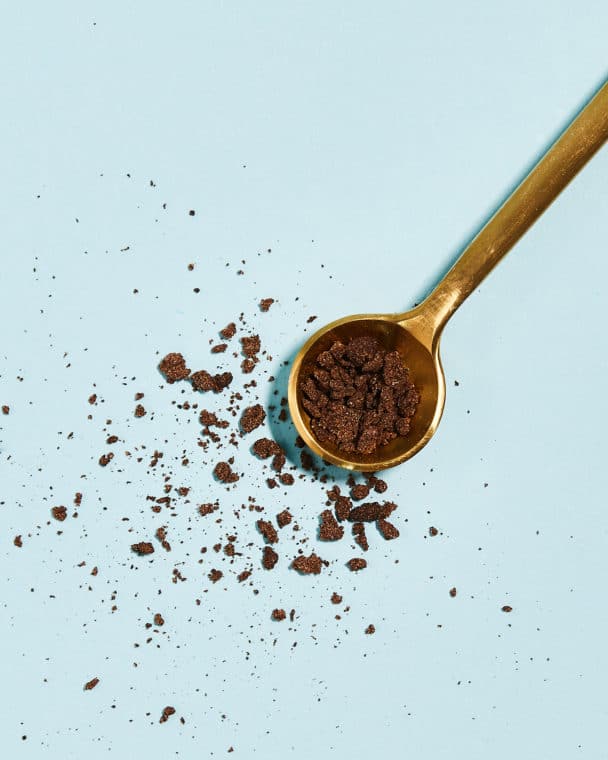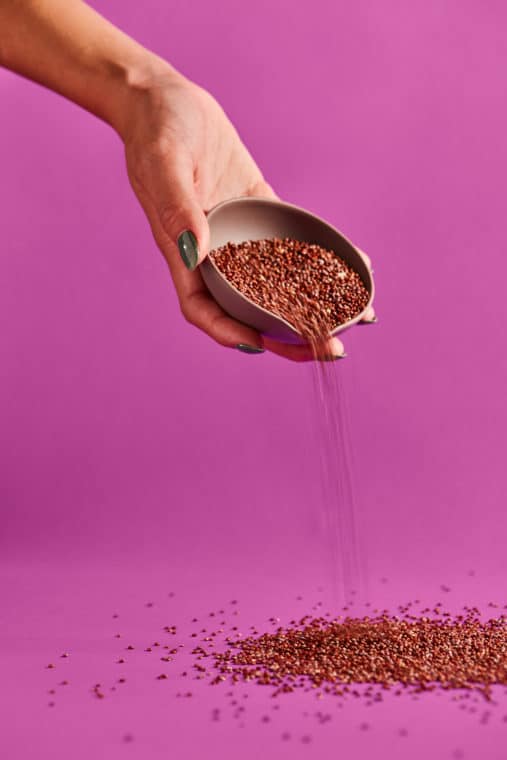We pride ourselves on using high-quality ingredients to make fun food with serious standards. We want the food we make for you to be nutrient-dense and filled with the goods to help you fuel your best self. Today, we’re breaking down 12 pantry staples that you’ll find in our meals & that we hope you’ll add to your pantry for home cooking!
1. Grass-fed Collagen

This is one of our FAVORITE pantry staples. Collagen is the perfect supplement to a healthy diet. While it occurs naturally in bone broth, shaking a little collagen into your morning coffee or tea makes for an easy way to boost your digestive, skin, hair & nail health. You can read all about collagen here. You can find collagen in the pop and bottle vanilla oak milk latte & in individual packets on our store shelves (we love Vital Proteins!).
2. Grass-fed ghee

Ghee is free of lactose & casein, meaning it usually works for even those sensitive to dairy. It’s packed with fat-soluble vitamins like A, E & K. It also contains Conjugated Linoleic Acid (CLA), which has a laundry list of benefits including potentially reducing inflammation, lowering blood pressure, preventing cancer formation & reducing body fat. It contains butyrate, a short-chain fatty acid with a role in gut health. You can find ghee in a lot of our meals, from our chicken tenders with turnip mash to our peppercorn steak!
3. Paleo Flour Mix

Our paleo baking mix contains almond flour, arrowroot starch, organic coconut flour & tapioca flour. When compared to traditional flour, this mixture has more protein, fewer carbs & healthy fats. It’s also grain-free, meaning it works for a wide range of lifestyles, from Whole30 to Paleo to Keto. This mix is what helps us make our amazing paleo breakfast sandwich bread & our “breaded” chicken.
4. Maple Syrup

Maple syrup sets itself apart from refined sugar thanks to minerals & antioxidants like zinc, manganese, calcium, potassium & iron. When choosing sweeteners, opt for nutrient-dense options like maple syrup, raw honey, dates, or molasses for a small added nutrient boost. Remember that these are all still sources of sugar, so paying attention to how much of them you’re eating or using is key. Want to read more about our stance on sugars? Head here!
5. Coconut Aminos

We recently transitioned our entire Snap-prepared menu to be soy-free, thanks in large part for the powerhouse that is coconut aminos. Coconut aminos are a liquid made from aged sap of coconut blossoms & sea salt. Compared to most soy sauce, coconut aminos are gluten and grain-free, plus lower in sodium. You can find coconut aminos in dishes like our peppercorn steak.
6. Tahini

As far as pantry staples go, we love this option for its healthy fat content and its delicious flavor. Tahini is made from toasted, ground sesame seeds and is used widely in cooking, particularly in Mediterranean and Asian cuisine. You’ll also find it as a central ingredient in hummus! Tahini is an awesome source of healthy fat, with 50% of the fat coming from monounsaturated fatty acids, which aid in reducing inflammation. It also contains manganese and phosphorous, key for bone health, along with thiamine and vitamin B6, both of which play a role in energy production. Aside from hummus, you can use tahini as a stand-alone dip for meat or vegetables, or add it to salad dressings or dips.
7. Forbidden Rice

Also called black rice, forbidden rice is a gluten-free heirloom rice that’s richer in antioxidants compared to other types of rice. Black rice is rich in anthocyanins, antioxidant pigments that give the rice its unique dark color. With 2g of fiber per 1/2 cup, forbidden rice has more fiber than red, brown, or white rice. Our favorite way to boost the nutrition of rice & grains is to cook them in bone broth!
8. Ashwagandha

Ashwagandha is a medicinal herb that’s considered an adaptogen, meaning it can help the body manage stress. In fact, ashwagandha has been used for over 3,000 years to boost energy, decrease stress & aid in concentration. Talk about an ancient remedy! Ashwagandha has also been shown in some studies to help manage & reduce blood sugar levels in humans. It also helps reduce cortisol levels, which is great considering there’s more than enough stress to go around these days. Chronically elevated cortisol levels can lead to blood sugar imbalances & increased fat storage (particularly in the belly). Suffer from anxiety or stress disorders? Ashwagandha can help with that too! Add ashwagandha to your coffee or tea.
9. Coconut Oil

Another awesome pantry staple, coconut oil is a great source of healthy fats, including brain-boosting medium-chain triglycerides (MCTs). Coconut oil has a high smoke point, so it can be great to use for cooking. It has a long list of benefits – including improved lipid profiles, reduced waist circumference, reduced inflammation, functioning as an antimicrobial, may help with weight loss, may help protect against Alzheimer’s, and may improve antioxidant status (studies below). While most of these benefits also assume you’re eating a generally healthy diet to start with, they’re impressive nonetheless.
10. Quinoa

Quinoa is one of the very few plant foods that’s a complete protein, meaning it’s a great option for vegetarians & vegans. Plus, it provides fiber, magnesium, B vitamins, potassium & more. We love using this gluten-free grain in our dishes for a boost of fiber and nourishing protein. Find it in our best-selling bison quinoa hash.
11. Apple Cider Vinegar

Apple cider vinegar (ACV) has been in the spotlight for a while, with proponents touting its ability to improve digestion & balance blood sugar. We recommend choosing raw apple cider vinegar, which contains the “mother”, a mix of proteins, enzymes & beneficial bacteria. ACV can be helpful for those trying to manage their blood sugars since it’s been shown to help insulin sensitivity & reduce blood sugar. Keep in mind, though, that ACV will be most beneficial in managing blood sugars when combined with a low carb, low sugar diet.
While there’s no research showing that ACV improves digestion, some people still swear by its effectiveness, particularly for high protein meals. In theory, since ACV is acidic, it increases the acidity in the stomach, helping your body create more pepsin (an enzyme that breaks down protein). The general recommendation here is to consume 1-2 tbsp in water before a meal. If you feel this improves your digestion when consuming a meal with protein, go for it!
When choosing your vinegar, opt for organic & unfiltered vinegar that still contains the “mother.” You can incorporate ACV into salad dressings or dilute it in water and drink it before or alongside meals. You can drink anywhere from 1 tsp to 2 tbsp per day, mixed in water.
12. Turmeric

Turmeric contains curcumin, known for its anti-inflammatory & antioxidant properties. Curcumin has also been linked to improved brain function & may help prevent cancer. It’s no wonder turmeric has the reputation for being a superfood. You can find turmeric in some of our third-party products. You can incorporate turmeric spice into your cooking, or add it to beverages, making it one of the most versatile pantry staples.
Although we love researching the latest & greatest food trends, nutrition & good health don’t have to be complicated. Often, simple, wholesome ingredients will have the biggest impact on your health & wellness journey.
Real food for the win! Do you already love or use any of these ingredients and pantry staples? Any you plan to use now that you’ve heard about the benefits? Let us know in the comments.





Leave a Reply
2 Comments
Thank you for providing an opportunity to give feedback. I have enjoyed your products for quite some time. However, I have become unable to tolerate my favorites one by one, as it seems the spice levels increase and they become too hot. This includes the salmon with coconut rice, turkey chili, black bean sliders, and the chicken with teriyaki rice. The other meals just aren’t the same. Will you consider lowering the spice level back down?
Thank you for the feedback Stephanie! We haven’t changed the spice level on any of these recipes, so we’ll be sure to communicate with the kitchen and make sure they’re following the recipes as written when it comes to spices.